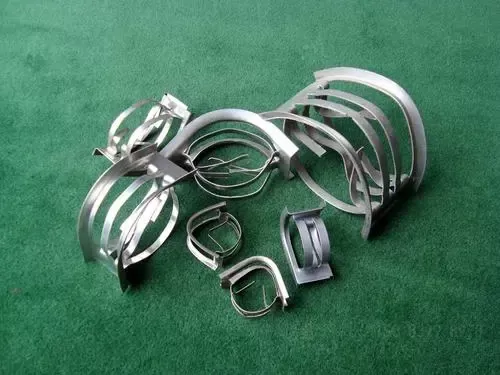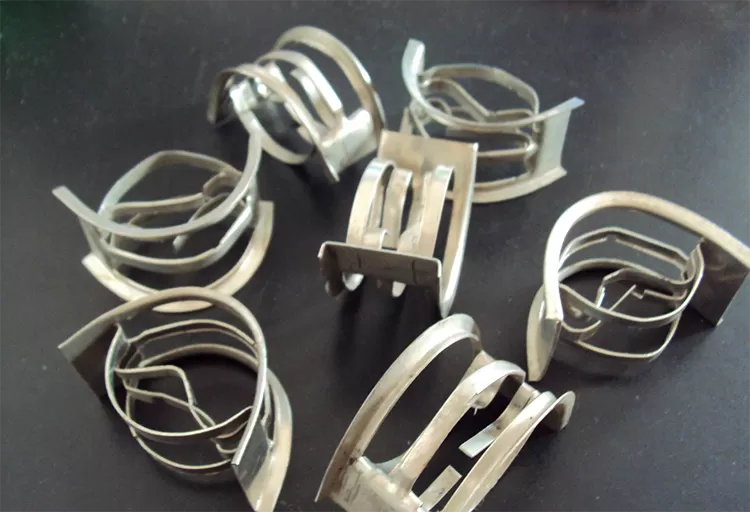The acid resistance of metal Intalox saddle packings is a critical consideration in industrial processes involving corrosive acidic fluids, as it directly impacts their durability, performance longevity, and operational reliability. While metals are generally susceptible to acid corrosion, the choice of alloy significantly determines the packing’s ability to withstand acidic environments, making material selection a key factor in process design.

Carbon steel Intalox saddle packings exhibit limited acid resistance, as they are prone to corrosion in the presence of most acids. Exposure to even dilute acids like hydrochloric (HCl) or sulfuric (H₂SO₄) acid causes rapid oxidation, leading to material degradation, pitting, and eventual structural failure. This makes carbon steel variants unsuitable for acidic applications, restricting their use to neutral or alkaline process environments.

Stainless steel Intalox saddle packings, particularly those made from 304 or 316 grades, offer improved acid resistance for many industrial applications. 304 stainless steel, containing chromium and nickel, resists corrosion in mild acids such as acetic acid and dilute sulfuric acid at moderate temperatures. However, it may still corrode in highly concentrated acids or environments with chloride ions, which can cause pitting or crevice corrosion over time.
316 stainless steel Intalox saddle packings provide enhanced acid resistance compared to 304 grades, thanks to the addition of molybdenum. This alloying element improves resistance to chloride-induced corrosion and extends protection to more aggressive acids, including dilute hydrochloric acid, phosphoric acid, and organic acids like citric acid. 316 stainless steel is widely used in chemical processing and pharmaceutical applications where moderate acid exposure is common.
For highly corrosive acid environments, specialized alloys like Hastelloy or Inconel are employed in Intalox saddle packing manufacturing. Hastelloy C-276, a nickel-molybdenum-chromium alloy, offers exceptional resistance to strong acids such as concentrated sulfuric acid, hydrochloric acid, and nitric acid, even at elevated temperatures. Inconel 625, another nickel-based alloy, provides similar protection against oxidizing acids and acidic chloride solutions, making it suitable for extreme acid service in industries like petrochemical refining.
The degree of acid resistance in metal Intalox saddle packings also depends on acid concentration and temperature. Even corrosion-resistant alloys may degrade in highly concentrated acids at high temperatures, as elevated temperatures accelerate chemical reactions between the metal surface and acid molecules. For example, 316 stainless steel can withstand 5% sulfuric acid at 60°C but may corrode in 20% sulfuric acid at 100°C, highlighting the need for temperature-specific material selection.
Surface finish and structural design influence the acid resistance of metal Intalox saddle packings indirectly. Smooth, polished surfaces reduce crevice formation where acid can accumulate, minimizing localized corrosion. The saddle-shaped geometry, with its open channels and uniform structure, promotes fluid drainage, preventing acid stagnation that could accelerate material breakdown in stagnant zones.
In industrial practice, acid resistance testing is conducted to validate metal Intalox saddle packing performance. These tests expose samples to simulated process conditions—specific acid concentrations, temperatures, and exposure durations—to measure corrosion rates and structural changes. Results guide alloy selection, ensuring the packing can maintain integrity for the required service life without excessive degradation.
Maintenance practices also impact the acid resistance of metal Intalox saddle packings. Regular cleaning to remove acid residues or corrosion by-products helps prevent cumulative damage, while proper installation to avoid mechanical stress reduces the risk of cracks where acid can penetrate and accelerate corrosion. In some cases, protective coatings may be applied to further enhance acid resistance, though this is less common than alloy selection for long-term protection.
In summary, metal Intalox saddle packings can be acid-resistant, but their performance depends on alloy composition, acid type, concentration, and temperature. From basic stainless steels for mild acids to specialized alloys for extreme conditions, selecting the right metal ensures reliable operation in acidic industrial separation processes.

